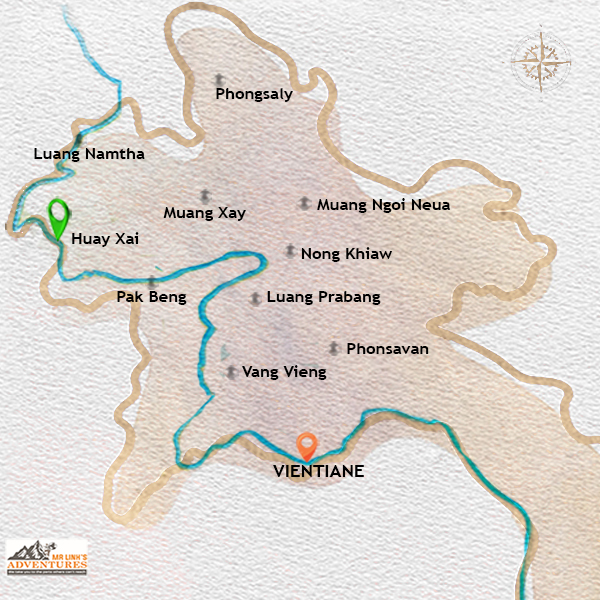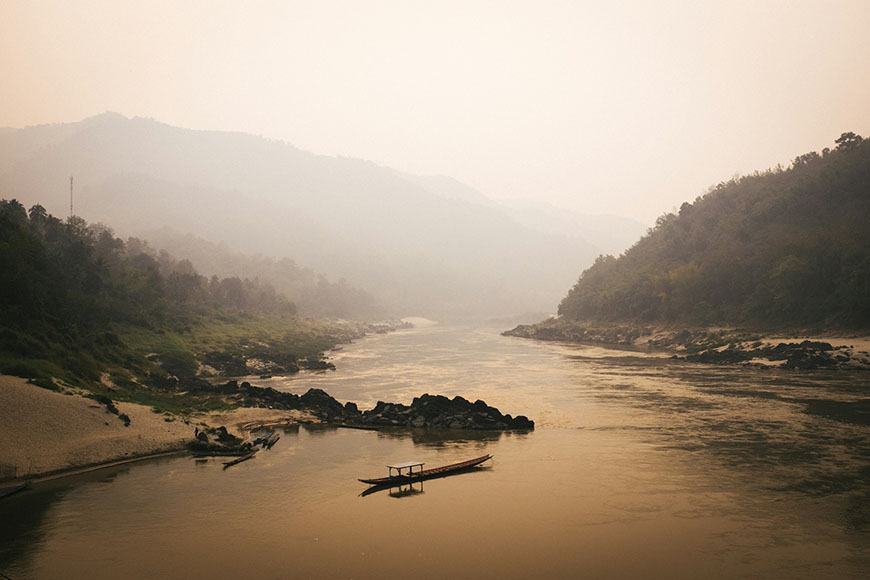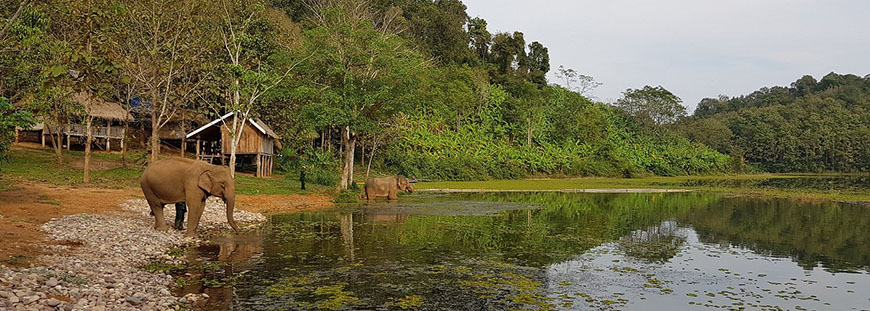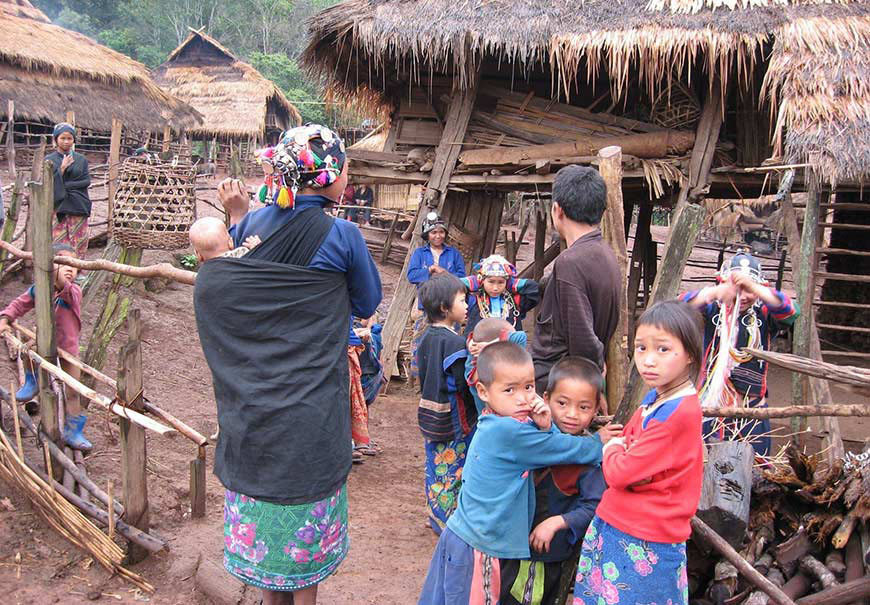 Overview
Overview
 The Middle Mekong
The Middle Mekong, this majestic part of the life-giving river, stretches between the Thai border and the province of Luang Prabang/Bokeo, passing through the provinces of Bokeo and Sainyabuli.
Far from the crowds, this region offers an authentic immersion into the wild nature and local culture of Laos. Here, time flows slowly, at the rhythm of the river, inviting discovery and sharing.
Beyond
Huay Xai and
Pak Beng, the adventure takes on another dimension: communication becomes a challenge; a Lao phrasebook can be invaluable. The west of Sainyabuli, meanwhile, is an invitation to exploration for the most audacious travelers.
 Top Attractions
Top Attractions
 Boat Cruise on the Mekong in Laos
Boat Cruise on the Mekong in Laos
For those seeking an authentic and enriching journey, Laos unveils a tapestry of natural beauty and cultural immersion.
Navigating the Mekong
Embark on a traditional boat and let yourself be lulled by the current, while admiring the spectacular landscapes that unfold before your eyes.
Meeting local communities
Interact with the inhabitants, discover their way of life, their traditions, and their crafts.
Exploring the wild nature
Venture into the lush forests, explore the mysterious caves, and admire the refreshing waterfalls.
Discovering Lao culture
Visit the Buddhist temples, soak in the peaceful atmosphere of the places, and learn more about local history and customs.
 See & Do
See & Do
The Gibbon Experience offers travelers a thrilling way to explore Laos' dense tropical forest
The "Gibbon Experience" is the main attraction of Huay Xai. This 2- or 3-day adventure takes you to discover the lush jungle, with spectacular zip lines and nights in treehouse cabins. The 3-day option offers better chances of observing gibbons in their natural habitat. The Gibbon Experience, a model of sustainable tourism, provides local communities with income greater than hunting, while protecting the forest and transforming former hunters into environmental guardians.
At the opposite end of the serenity of the Souvannakhomkharn ruins, the Golden Triangle, a kind of Lao Las Vegas, surprises with its exuberance. Hotels, casinos, and even a miniature Big Ben line Route 3, offering a spectacle that is unexpected, to say the least, in the surrounding countryside.
Sainyabuli, nicknamed the "elephant capital" of Laos, is a surprisingly urban city that only reveals its charms outside its walls. While the city itself offers few attractions, Lake Nam Tien, a few kilometers away, is a haven of peace where you can admire magnificent sunsets.

Sainyabuli Elephant Conservation Center, an enriching experience
While the Sainyabuli Elephant Conservation Center is an enriching experience, it also serves as a reminder of the fragility of these animals' existence in Laos. With only 400 wild individuals and 450 in captivity, their future is uncertain, between poaching and exploitation. An alarming observation that highlights the importance of conservation. To protect elephants, the conservation center supports mahouts by offering them financial compensation during the breeding period and "maternity leave" of their elephants. In addition, the Elephant Conservation Center offers a 7-day volunteer program for an authentic immersion into local life and a commitment to elephant protection.
Sainyabuli comes alive every year in mid-February during its elephant festival. For two days, the city celebrates these emblematic animals with parades, shows, and demonstrations. Music, theater, and local beer are also on the program for a festive and convivial atmosphere.
From Pak Beng, set off to discover the Hmong villages, either by renting a motorcycle or by calling on a local guide. An authentic immersion into the culture and traditions of this ethnic minority.
 Go Green
Go Green
Mr Linh's Adventures offers tailor-made tours to discover the Middle Mekong and its surroundings:
• Cruise on the Mekong and discovery of ethnic villages: A multi-day adventure that will take you to meet local communities, while offering you breathtaking landscapes.
• Trekking in the jungle and exploration of caves: An immersion in wild nature, discovering local fauna and flora.
• Combined Mekong and Luang Prabang: A trip that will allow you to discover the must-sees of the Middle Mekong and the city of Luang Prabang, a UNESCO World Heritage Site.
 Heritage
Heritage
 Hmong villages, an authentic immersion into the culture and traditions of this ethnic minority
Hmong villages, an authentic immersion into the culture and traditions of this ethnic minority
Huay Xai, the gateway to Laos for many travelers, offers a dual face: a discreet city by day, it comes alive at night, revealing a vibrant market and temples such as Wat Thasuvanna Phakham, Wat Khonekeo Xaiyaram, and Wat Keophone Savanthanaram, the latter housing astonishing scenes of torture.
Fort Carnot, a vestige of the French colonial era in Huay Xai, bears witness to a bygone past. Although only a few towers and the entrance gate remain, the site offers an interesting glimpse into the history of Laos.
In the heart of the Huay Xai countryside, the ruins of Souvannakhomkharn offer a timeless experience. This ancient city, although difficult to access and largely disappeared, retains an aura of mystery and serenity.
Pak Beng, an essential stop on the trip on the Mekong, is a charming small town where you can recharge your batteries away from the modern world. Here, life is punctuated by the river, and electricity is rare after 9 pm. Wat Sin Jong Jaeng, a historic temple overlooking the Mekong, is worth a visit for its architecture and its mural fresco depicting a European from the colonial era.
On the road between Sainyabuli and Loei, Pak Lai is a frequent stopover. This small town, although discreet, deserves a short visit for its temple (Wat Sisavang) and its colonial-style buildings.
 Food & Drinks
Food & Drinks
Khanon, the little goody from Laos
In Huay Xai, the local gastronomy offers a diversity of flavors. Several restaurants offer Hmong cuisine, often prepared with organic ingredients. The more adventurous can taste exotic specialties, such as frog or fried crocodile. To refresh themselves, the Daauw is renowned for its "Laojitos", a local variant of the mojito made with Lao-Lao, the Laotian whiskey.
In Pak Beng, there is a surprising concentration of Indian restaurants, while in Sainyabuli, there is no shortage of local specialties, from traditional sweets (Khanom) to more daring dishes (fried insects).
 Directions
Directions
Location
The Middle Mekong stretches between the Thai border and the province of Luang Prabang, in northern Laos.
How to get there
From Vientiane: You can take a bus or a domestic flight to Luang Prabang, then go up the Mekong by boat.
From Ha Noi: You can take a direct flight to Luang Prabang, then follow the same route.
Ticket price: Prices vary depending on the mode of transport and the company chosen. It is advisable to book in advance, especially in high season.
Best season to visit
The dry season, from November to April, is the ideal time to visit the Middle Mekong. Temperatures are pleasant and rainfall is rare.